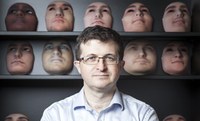« My career at Idiap allowed me to establish a standard »
Today, Sébastien Marcel is leading the Biometrics and privacy research group. During two decades he developed Idiap’s biometrics skills, even creating a world renowned dedicated center. He reflected on his unique professional path.
How did you join the institute?
I arrived on a Sunday of November in Martigny, where everything was closed. I wasn’t aware of where I was about to land, as media were mentioning terrible floods in Valais. Thankfully, there was nothing in Martigny. Following my PhD in a France Telecom lab, todays Orange Labs, I had worked on artificial neural networks applied to gesture recognition in computer vision. A very futuristic topic at the time, 10 years prior to Microsoft’s Kinect. The leader of this lab was nobody else than the father of Ronan Collobert [editor’s note, a former Idiap researcher who developed the reference software Torch], who told me about Idiap and also advised me to ask Joshua Bengio to be a committee member for my thesis, regarding my research theme. Based in Montreal, Bengio redirected me to his brother Samy who was… at Idiap. So it was quite natural for me to apply at the institute, once my PhD finished. Hervé Bourlard–already director at the time–invited me then for a presentation at the institute, quickly followed by a job offering.
Which research areas did you developed when you arrived at Idiap?
When I started, there was no more specialist in computer vision at Idiap. I naturally continued my thesis research to apply it in the framework of the European project BANCA in the… biometrics area. The aim was to use artificial neurones techniques to recognize faces. This is how our skill in face recognition developed, collaborating among other with the machine learning team, leaded at the time by Samy Bengio, now researcher at Google Brain. The attribution of new European projects and the involvement in the NCCR IM2 financed by the Swiss National Science Foundation helped to consolidate this first phase.
The turning point was in 2008 with the European project MOBIO on mobile biometry we coordinated. The goal was to do face and voice recognition on mobile phones. Another visionary topic at the time, as there was no iPhone when we submitted the project, and seeing how mobile biometrics are used today. Meanwhile, the team was slowly but surely growing. So, in 2010, we created the biometrics research group and we were awarded the coordination of the European project Tabula Rasa, focusing on ant-spoofing [editor’s note: methods to prevent biometrical identity theft]. This project put us under the spotlights, especially for businesses, and we became a leader in the domain.
How did you manage to do public research in a domain where businesses are playing a key role?
With the project Tabula Rasa we have broken a taboo. Spoofing was a topic for spy movies, not for a research you could speak about openly. Two years later, in 2012, the European project BEAT–we also coordinated–played another pivotal role by creating a platform offering robust open source tools for biometry. The aim was to create a standard. This is why in 2016, we also decided a dedicated center, which could take off thanks to the support of the State of Valais and the City of Martigny, who believed in the project. Our expertise was quickly recognised, as we obtain the FIDO [editor’s note: an international benchmark consortium] and Android accreditations to certify biometrical systems following their standards. We also integrated an American collaborative research center, the CITeR. Today, we struggle to keep the pace with the numerous needs and requests.
Wouldn’t it have been easier to conduct this research in the private sector?
Sure, there was a lot of opportunities in the private sector, but I probably wouldn’t have the same freedom. My vision was an open source strategy on the long term to insure the transparency and the reproducibility of the work. Taking this path was certainly longer and harder, as research financing mechanisms are not fully adapted, but it pays in the long run. This career choice allowed me to create a standard. For example, tools and data bases developed by the BEAT and Tabula Rasa projects are still references and are still developed and updated. If the first years weren’t always easy and sometimes we had to have strategical flair, this freedom and this opportunity to follow long term goals make the difference today. This would have not been possible elsewhere. Thanks to its infrastructures and opportunities, Idiap is some sort of sweet spot between public and private sectors.
So, what’s next?
The evolution is going naturally, for example with projects related with deepfakes, but also including a bigger part to teaching. Being able to share this knowledge and expertise thanks to courses at the University of Lausanne, EPFL or included in Idiap’s Master in artificial intelligence is another long term investment possible at the institute.
More information
- Biometrics Security & Privacy group
- Swiss Center for Biometrics Research and Testing
